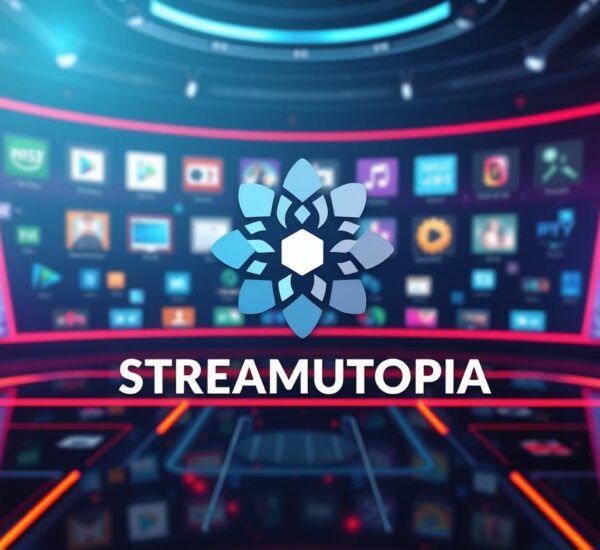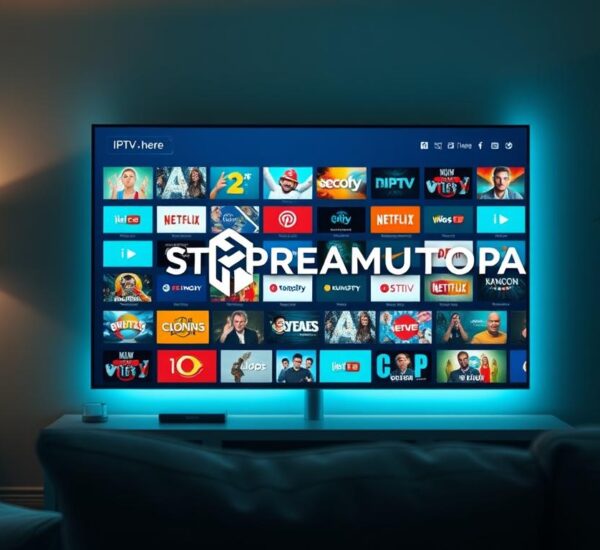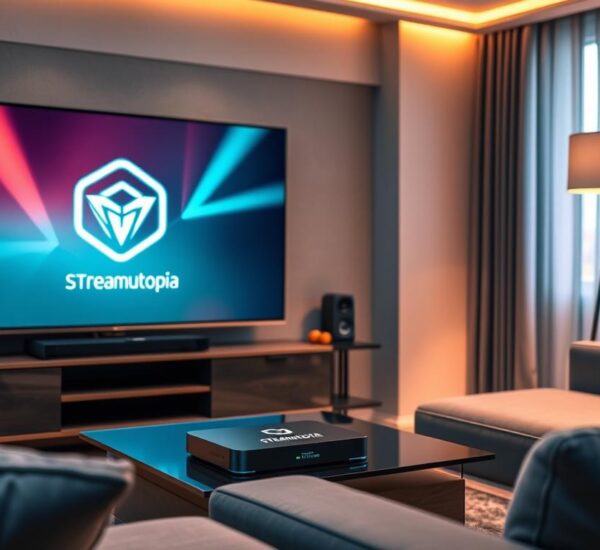Have you ever thought about how IPTV and OTT services might change how we watch TV? These two platforms are becoming more important as the IPTV market grew to about $50.9 billion in 2021. It’s expected to jump to $115.2 billion by 2026, growing at 17.8% a year1. With 5G making streaming better, and big markets like Asia-Pacific and Europe supporting it, IPTV is a big deal in digital media1.
This article will show you the main differences between IPTV and OTT. We’ll look at how they deliver content and what makes them special. You’ll see why IPTV is a strong choice, even as OTT gets more popular. It’s key for anyone trying to pick the best way to watch shows and movies.
Key Takeaways
- The IPTV market is set to grow a lot, going from about $50.9 billion in 2021 to around $115.2 billion by 20261.
- IPTV and OTT offer different ways to watch TV, each with its own benefits.
- 5G is making IPTV better by improving access and quality.
- Asia-Pacific and North America are leading in IPTV use, thanks to fast internet and support from laws1.
- StreamUtopia shows IPTV’s potential with flexible plans for different viewers.
Understanding IPTV and OTT Technologies
IPTV and OTT services are two ways to stream videos over the Internet. IPTV is a paid service that uses a special network for a stable connection. It gives a clear image and sound without breaks2. You can find IPTV services like Verizon Fios TV, DIRECTV STREAM, Movistar +, and Orange TV.
OTT services use your internet connection, making them easy to scale and reach more people. You can watch videos on devices connected to the internet2. Unlike IPTV, OTT lets you watch videos when you want. Many OTT services are free or start at $4.99 a month3.
To use IPTV, you need an internet connection, a router, and a set-top box. OTT services work on any device with internet, using Wi-Fi or mobile data2. Both IPTV and OTT use AI for recommendations, but OTT is more flexible and cheaper. This makes OTT great with 5G and fast internet3.
| Aspect | IPTV | OTT |
|---|---|---|
| Delivery Method | Private network | Existing internet connections |
| Subscription Model | Typically more expensive | Various options, including free ad-supported |
| Content Delivery | Multicast | On-demand |
| Quality | Stable and high-quality streaming | Variable quality, can experience buffering |
| Device Compatibility | Requires set-top box | Accessed via multiple devices |
Key Differences Between IPTV and OTT Services
The key differences between IPTV and OTT services are mainly in how they deliver content, how they engage users, and their pricing. IPTV is often given by telecom operators and uses managed networks for a quality broadcast-like experience. This makes streaming more reliable than OTT, which uses the public internet4.

Both IPTV and OTT give users content they like, but their delivery methods are different. The way they deliver content is a big difference. IPTV needs a fast internet connection for streaming videos and live TV. OTT works well with slower internet speeds, making it easier to use on many devices5.
IPTV mainly has licensed content, while OTT has more variety, including user-made videos and content from different websites4. Setting up IPTV is harder and costs more because it needs special equipment. OTT is easier to start and costs less, offering a simple experience for users5. So, the choice between IPTV vs OTT depends on what kind of content and ease of use you want in a changing media world.
IPTV vs OTT: Definition and Overview
Learning about the IPTV definition and OTT definition helps us see how TV delivery is changing. IPTV sends TV shows over the internet using IP networks. It needs special bandwidth and focuses on live channels. In 2022, the IPTV market was worth USD 59.68 billion, showing its big role in TV6.
OTT, or Over-The-Top, is a way to watch shows online without needing cable or satellite. It lets viewers pick their own prices and access content easily, since anyone with internet can use it. By 2029, OTT video is expected to reach about 6.4 billion users worldwide6.
IPTV is great for live events because it streams reliably. It uses special tech to keep the quality high. OTT, on the other hand, stores content online and adjusts to internet speed, which can change how well it streams7. As people want more choices, IPTV and OTT are getting better, leading to fewer people using traditional TV by 20308.
IPTV Features and Technology
IPTV uses advanced tech to deliver content. It works through set-top boxes or smart TVs on fast internet. Users get to watch live shows and on-demand videos, making their experience better.
Delivery Method of IPTV
The way IPTV delivers content is key to its quality and reliability. It uses a subscription model, often tied to internet services from ISPs. This setup makes IPTV more costly than OTT services. Also, it’s limited by region, offering content specific to where you live9.
Content Sources for IPTV
IPTV gets its content through deals with networks and exclusive rights. It’s different from OTT, which pulls content from many sources over the internet. IPTV’s focused approach means it offers a wide range of content, including live TV and interactive features. This makes it appealing to those wanting more from their viewing experience4.

| Feature | Description |
|---|---|
| Delivery Method | Streaming with real-time broadcasts and VOD options, requiring dedicated infrastructure. |
| Subscription Model | Typically bundled with ISP services, resulting in higher operational costs. |
| Content Sources | Exclusive rights agreements with networks, focusing on region-specific offerings. |
| Technological Integration | Blends internet connectivity, multimedia, and communication for enhanced user experience. |
IPTV technology keeps getting better, offering features for different needs. It uses modern digital tools to improve user experience. Knowing about IPTV’s key points helps users and providers in the fast-changing media world94.
OTT Delivery Methods
OTT delivery methods change how we watch videos, using streaming protocols for a better experience. Two main protocols are HLS (HTTP Live Streaming) and DASH (Dynamic Adaptive Streaming over HTTP). These break videos into smaller pieces for smooth playback on different networks. This means viewers face fewer breaks and enjoy high quality, even on slow connections.
OTT platforms let you watch content anywhere, making them more attractive than IPTV, which is limited by location. For example, streaming options are now more popular worldwide.
Streaming Protocols Used in OTT
Streaming protocols are key for smooth internet video streaming. HLS works well with many devices, and DASH is great for adapting to different speeds and devices. These technologies make watching videos more dynamic and enjoyable.
Content Accessibility via OTT
OTT makes it easy to watch shows and movies on various devices without special gear. This flexibility is a big plus of OTT, making it cheaper and more convenient than IPTV. While IPTV targets specific groups and costs more, OTT reaches people all over the world with just an internet connection.
The OTT video market is expected to grow to about 6.4 billion users by 2029. This shows how much people want easy access to their favorite content9.
IPTV and OTT are both changing, each offering unique benefits for different viewers. Knowing these differences helps people pick the best service for their viewing habits10.
Comparative Analysis: IPTV vs Streaming
The entertainment world has changed a lot with IPTV vs streaming services. These services meet different needs, each with their own IPTV advantages and experiences.
IPTV mainly offers traditional TV channels and live broadcasts. This is different from streaming, which focuses on on-demand content. IPTV usually has better quality because of its own network. This makes it great for those who want a smooth viewing experience1112.
On the other hand, streaming lets you watch movies, TV shows, and live sports whenever you want. OTT services are often cheaper, starting at $4.99 a month12. But, the quality might drop during busy times due to internet issues1113.
A detailed guide on installing IPTV services shows how to get live TV and on-demand content on devices like the Amazon Fire TV Stick.
OTT services are available worldwide, while IPTV is often for specific regions. This affects the content you can watch1312. Many people choose OTT for its wide range of shows. Others prefer IPTV for its high-quality streaming with fewer breaks13.
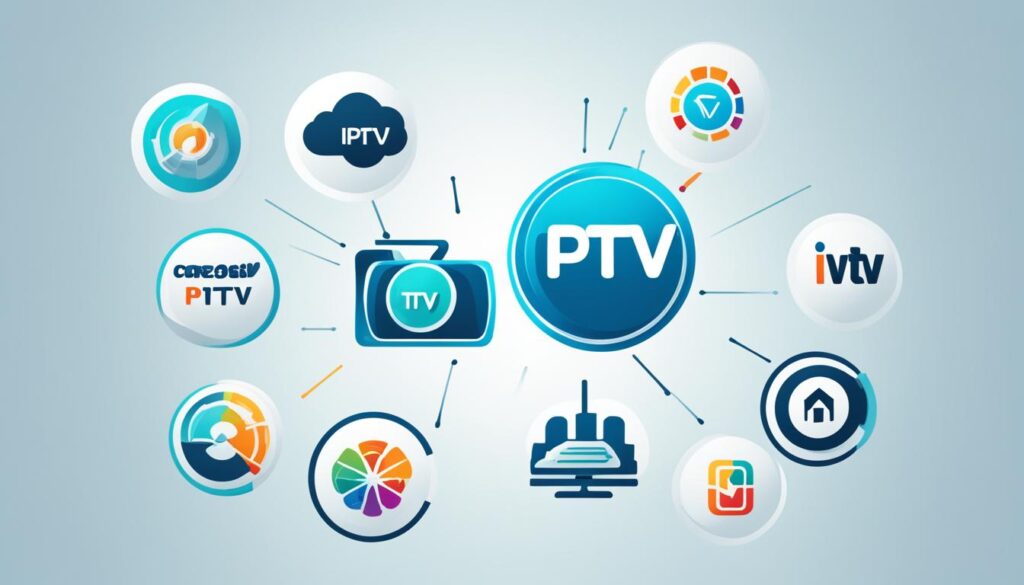
Choosing between IPTV and streaming depends on what matters most to you. This could be availability, cost, variety of content, or quality. As both options keep getting better, knowing their unique features is key for a better viewing experience.
Advantages of IPTV
IPTV is becoming popular because it offers many benefits that make watching TV better. One big plus is its high-quality service. This is thanks to the special bandwidth it uses. This means less buffering and no interruptions, which is great for viewers. In fact, 21% of U.S. households have ditched traditional TV, and more are likely to follow14. IPTV also lets many people watch the same content at once without slowing down14.
Quality of Service in IPTV
IPTV beats traditional TV in quality. It costs between $15 to $30 a month, which is a good deal for the quality you get14. You get reliable and clear viewing, making your entertainment time enjoyable.
Channel Variety in IPTV Services
IPTV providers offer a lot of channels. For example, Xtreme HD IPTV has over 4,000 live TV channels and lots of VOD content15. CatchON TV takes it up a notch by letting you pause, rewind, and fast-forward live TV15. NomadIPTV is great for watching shows on different devices at the same time, showing how flexible IPTV can be15.
| Service Provider | Channel Count | Features |
|---|---|---|
| Xtreme HD IPTV | 4,000+ | Live TV + VOD |
| CatchON TV | Varied | Pause, Rewind, Fast-forward |
| NomadIPTV | Varied | Multiple device access |
With its high quality and lots of channels, IPTV is meeting the needs of today’s viewers.
Benefits of OTT Services
OTT services have changed how we watch shows and movies. They offer many benefits that meet today’s viewer needs. These platforms let users pick plans that fit their likes without long-term deals. Services like Netflix, Hulu, and Amazon Prime Video give more content choices than traditional TV, making watching more fun1617.
Flexibility and Scalability of OTT
OTT services are great because they’re flexible and scalable. You can watch on devices like Smart TVs, tablets, and phones. This lets you watch what you want, when you want, which is key for today’s viewers18. Plus, they offer unique shows you can’t find elsewhere, making their content richer and more varied16.
Cost Efficiency of OTT Subscriptions
OTT subscriptions are a hit with young people who want to save money. They cost less than regular TV packages and don’t add extra charges for internet and phone. This makes it easy to enjoy lots of channels without spending a lot1617. By skipping traditional TV, OTT lets viewers control their spending and enjoy shows they like18.
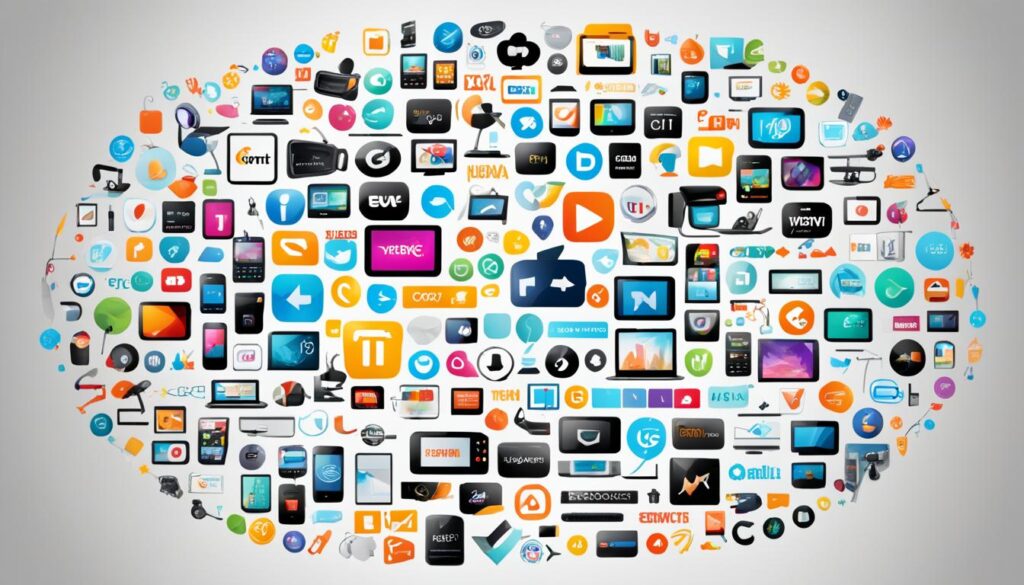
Technological Nuances: IPTV vs OTT
Exploring the tech behind IPTV technology and OTT technology shows how they work. IPTV uses a strong network for steady quality and reliability. It offers on-demand services like Live TV, Time-shifted programming, and Video on demand19.
OTT uses the internet you already have, but its quality can change with your internet speed. This can affect how well it works, especially since many Americans stream TV every month20.
OTT has grown a lot, beating cable TV for the first time in July 202221. Now, 61% of people aged 18-29 watch TV only through streaming. Only 31% use traditional cable or satellite20.
IPTV is made for growth, adding or changing content easily. OTT can do this too, but sometimes at a lower quality level. IPTV also supports two-way communication for features like pausing and rewinding content21.
This difference in tech opens doors for advertisers. OTT ad revenue is expected to jump from 45% to 60% in the next decade. CTV ads make up about 10% of all TV ad money20.
| Aspect | IPTV Technology | OTT Technology |
|---|---|---|
| Infrastructure | Managed network system | Mainstream internet infrastructure |
| Content Types | Live TV, Video on Demand | Streaming services |
| Reliability | High and consistent quality | Variable, dependent on internet |
| Scalability | Easily accommodates additions | Flexible based on internet capability |
IPTV Regulatory Environment
The rules for IPTV services are complex, with many IPTV regulations and standards. Providers must follow these rules to operate legally and effectively in the U.S. By 2026, 80 million households might stop their TV services. This will lead to a big drop in traditional cable and satellite TV use22. IPTV providers need to follow strict laws and get the right licenses for broadcasting, making things harder for them23.
Now, streaming services are more popular than traditional TV, showing a 0.4% increase in market share. This change shows how consumer tastes are shifting and affects the rules22. Cable and satellite TVs will have less than 50% market share in the U.S. by late 2023. This means IPTV services need strong rules to follow, especially about what content they can show and how to make money from it.
Connected TVs (CTVs) have a 38% market share in the U.S., showing a big preference for internet-based viewing22. IPTV uses broadband and set-top boxes, making it hard to deliver good content across different devices. OTT platforms are getting more popular because they offer flexible viewing options. This makes IPTV operators need to keep up with changing rules and what users want24.
The mix of IPTV and OTT services means IPTV rules are always changing. As users watch content on different devices, they’re moving away from traditional TV. Providers need to keep up with new IPTV rules and make their services better for users.
| Aspect | IPTV | OTT |
|---|---|---|
| Delivery Method | Private Network | Public Internet |
| Device Accessibility | Set-top Boxes | Multiple Devices |
| Regulatory Compliance | Strict Licensing | Flexible Regulations |
| User Control | Manageable Content | Greater Freedom |
| Revenue Models | Memberships and Add-ons | Advertising and Subscriptions |
OTT Regulatory Landscape
The rules for Over-the-Top (OTT) services are not as clear as those for traditional IPTV. This means there’s a big focus on how content is delivered rather than on telecom laws. As OTT services become more popular, a report by the BoR (16) 35 shows they’re becoming more important. It points to a move towards using IP technology25. Also, OTT services are divided into three types—OTT-0, OTT-1, and OTT-2—to make things clearer25.
There’s a big challenge in defining what electronic communication services (ECS) are in the fast-changing OTT world. This confusion makes it hard for Member States to understand ECS25. Regulatory Authorities (NRAs) struggle to get info from OTT-1 and OTT-2 providers. This makes it hard for them to fully understand the market25. This can make it tough to follow OTT rules and regulate them properly.
Recently, a new law proposal was made on November 10, 2023. It aims to create a unified set of rules. This law covers things like digital cable TV and OTT content. It says services must follow a government-set program and ad code26. This will help keep an eye on things, making sure shows are rated and available to everyone, even people with disabilities26.
Gathering data is key to making good rules. Asking for clear definitions of ECS helps keep up with tech changes. It makes it easier to include OTT services25. Tools like Zype and Brightcove’s adaptive bitrate streaming help with this. They make OTT rules and oversight more data-driven27.
User Experience: IPTV vs OTT
IPTV and OTT services offer different ways to watch TV, changing how we enjoy our favorite shows. IPTV gives you live channels and on-demand content over a managed network. This means high-quality video and audio without interruptions, making viewers happy. OTT, on the other hand, lets you pick what you want to watch when you want it, using any device.
Technology makes IPTV stand out with its private networks for better performance. Services like Verizon Fios TV and DIRECTV STREAM show this with great live TV and on-demand choices. OTT platforms like Netflix and YouTube offer a wide range of content, perfect for watching anywhere. This flexibility is why more U.S. households are dropping traditional cable28.
Cost is a big factor in choosing between IPTV and OTT. IPTV usually costs more, between USD 15 and USD 30 a month28. OTT can be cheaper, with some even offering free options28. But, OTT’s quality can change based on your internet speed. New hybrid models are coming, mixing IPTV and OTT features for a better experience.

| Factor | IPTV User Experience | OTT User Experience |
|---|---|---|
| Content Delivery | Managed Network (private) | Public Internet (unicast) |
| Quality | High quality, no interruptions | Varies by internet connection |
| Subscription Cost | Higher (USD 15-30/month) | Lower with free options available |
| Flexibility | Less flexible, structured packages | Highly flexible, on-demand access |
| Content Type | Live TV + on-demand | Variety of content options |
In summary, IPTV and OTT services offer unique experiences for different tastes, shaping the future of TV watching.
Market Trends in IPTV and OTT
The IPTV and OTT markets are always changing as how we watch shows shifts. High-speed internet is key for IPTV, making sure streams don’t stop or buffer29. OTT is moving towards making content just for you, letting new creators shine30.
Big names like Netflix, Amazon Prime Video, and Hulu lead the way with unique shows and options for viewers31. As fewer people stick with traditional cable, streaming services must keep improving to keep viewers. They’re now using different ways to make money, like subscriptions and ads, for IPTV and OTT31.
Technology is changing IPTV and OTT too. Fast content delivery networks (CDNs) make streaming quicker, and security keeps content safe30. Muvi One helps streaming services start fast, giving them an edge31.
More people are choosing streaming over traditional TV, changing what viewers want and expect. The choice between live TV and on-demand shows is making streaming more diverse and exciting29. This change shows how IPTV and OTT are becoming more important in the entertainment world.
Future of IPTV and OTT Services
The future of IPTV and OTT services looks bright and fast-changing. With 5G networks, streaming technology will improve a lot. This means better quality and speed for viewers. We’ll see these two services merge, offering the best of both worlds.
OTT services like Netflix and Hulu are already big hits. They offer lots of shows and movies on demand. This is making many people switch from traditional cable TV32.
IPTV is known for its reliable and high-quality streams. It’s less affected by internet slowdowns. As people want steady stream quality, IPTV from providers like AT&T U-verse will grow. They offer live TV and on-demand content. People might prefer platforms that let them surf channels like traditional TV but still offer OTT’s flexibility32.
The tech behind IPTV and OTT will keep getting better to meet new demands and rules. OTT devices might struggle with high-quality streams. But, future updates could improve how these services work on different devices and networks. This could make streaming smoother across the board33.
In short, IPTV and OTT services are set to grow with new tech, better content delivery, and more choices. As streaming grows, both will keep changing. This could change how we watch our favorite shows and movies.
| Feature | IPTV | OTT |
|---|---|---|
| Delivery Method | Managed networks via ISPs | Over-the-top internet delivery |
| Content Type | Live TV and on-demand | On-demand libraries from platforms |
| Quality Consistency | Reliable with less congestion | Variable, dependent on internet quality |
| Device Requirement | Requires IPTV box | Accessible via multiple device types |
| User Experience | Traditional channel surfing | App-centric control over content |
Conclusion
IPTV and OTT services are different and offer unique benefits to viewers. IPTV uses a dedicated network for high-quality live TV and some on-demand content34. OTT services work on the internet, giving easy access to on-demand content and using a pay-as-you-go model35.
IPTV gives a steady experience with better sound and video quality because of its private network. But, it can be expensive, making it hard for some to start34. OTT uses the internet, so quality can change based on your internet speed. This makes it flexible but not always reliable35.
When choosing entertainment, think about what you watch and how much you can spend. The way we get media is always changing.
Services like StreamUtopia show how IPTV can meet many needs. They offer a great choice for those looking at IPTV and OTT services36.
FAQ
What are the key differences between IPTV and OTT services?
How do IPTV and OTT technologies work?
What are the advantages of using IPTV over OTT?
Can you explain the benefits of OTT services?
How do regulatory environments differ between IPTV and OTT?
What are the user experience differences between IPTV and OTT?
What trends are currently shaping the IPTV and OTT markets?
What is the future outlook for IPTV and OTT services?
Source Links
- What is IPTV? Everything You Need to Know in 2024 – IPTV USA – https://buyiptvusa.com/what-is-iptv/
- IPTV vs. OTT – Internet TV Explained – https://corp.kaltura.com/blog/iptv-ott/
- IPTV vs OTT: Key Differences and Choosing the Right Option – https://www.enveu.com/blog/iptv-vs-ott/
- Differences between IPTV and OTT TV-IPTV vs OTT -RicherLink – https://www.richerlink.com/iptv-and-ott-tv/
- OTT Vs IPTV: Which One Is Better For Video Streaming? – https://www.mogiio.com/ott-vs-iptv-which-one-is-better-for-video-streaming/
- What is the Difference Between IPTV and OTT? – https://castr.com/blog/iptv-vs-ott/
- The difference Between IPTV and OTT MwareTV – https://www.mwaretv.com/newsroom/difference-between-iptv-and-ott/
- What is the Difference Between OTT Vs IPTV? – https://www.vplayed.com/blog/difference-between-ott-vs-iptv/
- Key Differences in Modern Video Streaming – Jaze Networks – https://www.jazenetworks.com/tech-news/iptv-and-ott-key-differences-in-modern-video-streaming/
- IPTV vs. OTT: Internet TV Delivery Systems Explained – https://www.dacast.com/blog/iptv-vs-ott/
- OTT vs IPTV – What are it’s Best Differences in 2023 – https://blog.flicknexs.com/ott-vs-iptv-choosing-your-perfect-entertainment-companion/
- IPTV vs. OTT – Internet TV explained.docx – https://www.slideshare.net/slideshow/iptv-vs-ott-internet-tv-explained-docx/270812315
- Difference between OTT and IPTV – GeeksforGeeks – https://www.geeksforgeeks.org/difference-between-ott-and-iptv/
- OTT vs. IPTV — What Are the Differences? – https://target-video.com/ott-vs-iptv/
- IPTV vs OTT : What Are the Differences? – https://mps.live/blog/details/difference-between-iptv-and-ott
- IPTV vs OTT: Comparing Content Availability, Pricing, and User Experience – https://www.linkedin.com/pulse/iptv-vs-ott-comparing-content-availability-pricing-user-deepak-joshi
- IPTV and OTT Services: Understanding the Differences and Making the Right Choice – IPTV WHALE – https://iptvwhale.com/iptv-and-ott-services-understanding-the-differences-and-making-the-right-choice/
- What is OTT? | Telestream – https://www.telestream.net/video/solutions/what-is-ott.htm
- OTT & IPTV An analysis presentation from ordering & billing perspective – https://www.slideshare.net/slideshow/ott-iptv/25906454
- Connected TV vs OTT : Keynes Digital – https://keynesdigital.com/connected-tv-vs-ott/
- A Guide to Understanding the Differences Between Consumer IPTV and Hotel IPTV Solutions – MDM – https://www.mdmcommercial.com/mdm-lodging-news/a-guide-to-understanding-the-differences-between-consumer-iptv-and-hotel-iptv-solutions/
- What Is the Difference between OTT and IPTV? How Do They Function? | VlogBox – https://vlogbox.com/what-is-the-difference-between-ott-and-iptv-how-do-they-function/
- IPTV vs OTT – the only real difference left is promotion or not of the custom STB – https://www.linkedin.com/pulse/iptv-vs-ott-only-real-difference-left-promotion-custom-matt-vidmar
- IPTV and OTT concepts, these you must know – https://www.videostrong.com/news-show-53
- BEREC Report on OTT services – https://www.berec.europa.eu/sites/default/files/files/document_register_store/2016/2/BoR_(16)_35_Report_on_OTT_services.pdf
- Analysis of the Draft Broadcasting Services (Regulation) Bill, 2023 — THE LEX TIMES – https://www.thelextimes.com/analysis-of-the-draft-broadcasting-services-regulation-bill-2023/
- OTT Broadcasting: Detailed introduction and Platform Selection – https://mps.live/blog/details/what-is-ott-broadcasting-and-best-ott-service-providers
- OTT vs IPTV — What Are the Differences? You Need to Know – https://medium.com/@WebnexsVOD/ott-vs-iptv-what-are-the-differences-you-need-to-know-f1b67247cac9
- Whats is Different Between OTT Box and IPTV Box? – https://www.mecool.com/blogs/news/whats-is-different-between-ott-box-and-iptv-box?srsltid=AfmBOorVR0NAMAhv3QzdIRE8F1sErdYalZ3KGDlJxxA8OURJAqf1HFgk
- The Trends in IPTV and OTT Services – AlphaOTT – https://www.alphaott.com/the-trends-in-iptv-and-ott-services/
- Get This Straight: OTT vs IPTV | Stream Verse IPTV – Muvi – https://www.muvi.com/blogs/get-this-straight-ott-vs-iptv/
- TV Choices Explained: Cable, Satellite, IPTV, and OTT – Vels Fibernet – https://velsfibernet.com/tv-choices-explained-cable-satellite-iptv-and-ott/
- Whats is Different Between OTT Box and IPTV Box? – https://www.mecool.com/blogs/news/whats-is-different-between-ott-box-and-iptv-box
- Understanding the Difference Between IPTV and OTT – https://blog.flicknexs.com/understanding-the-differences-between-iptv-and-ott/
- OTT vs. IPTV: Understanding the Future of Television Streaming – https://www.shreeagt.com/blog/ott-vs-iptv-understanding-the-future-of-television-streaming
- Over-the-top media service – https://en.wikipedia.org/wiki/Over-the-top_media_service




